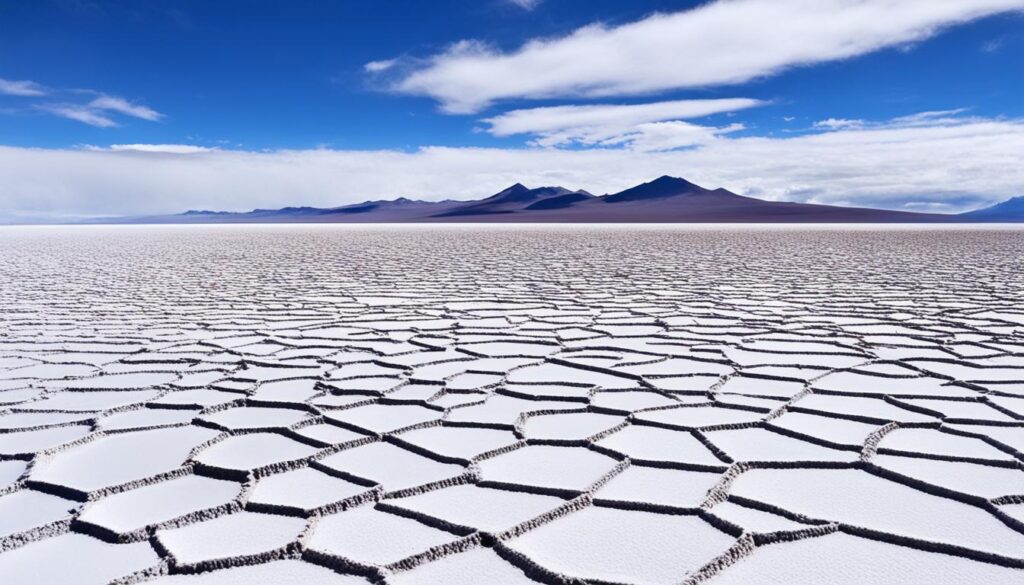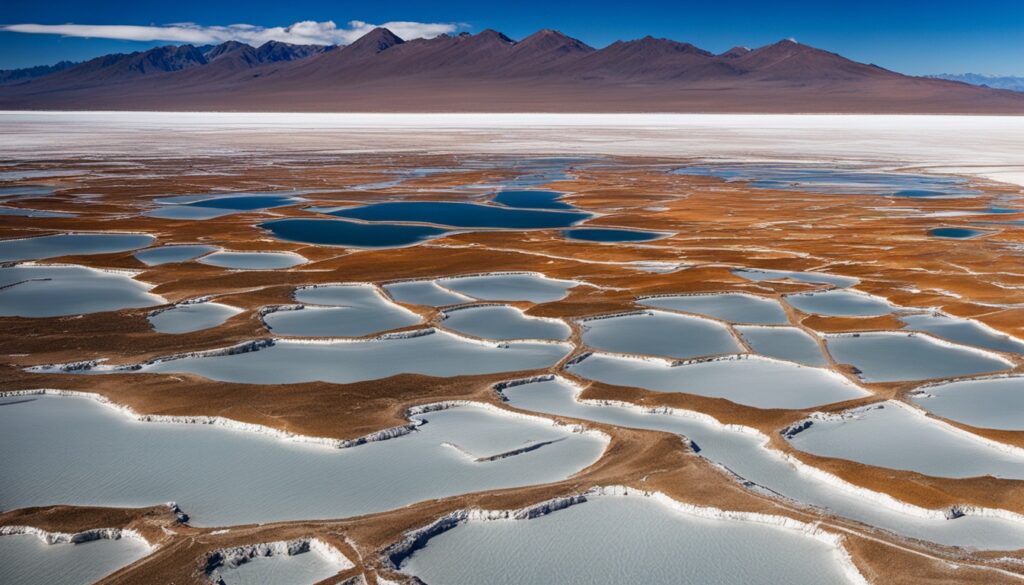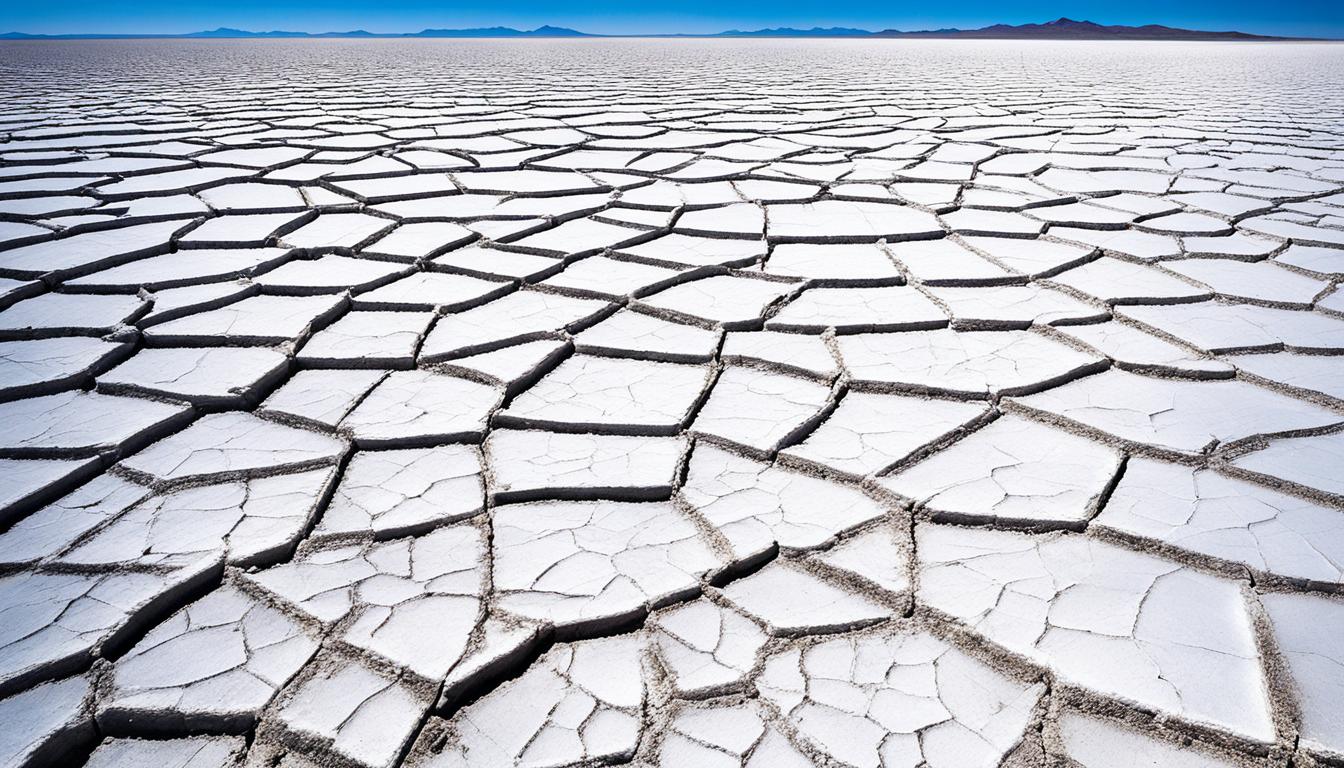The Uyuni salt flat in Bolivia was once part of a huge ancient lake called Lake Poopó. It was Bolivia’s second largest lake. This lake was home to over 200 species of birds, mammals, and fish. But, it has dried up in recent years because of droughts and climate change. This has caused a big ecological disaster.
Key Takeaways
- Lake Poopó, once covering 3,000 square kilometers, has completely vanished, leaving empty fishing villages and abandoned adobe homes.
- Droughts and climate change have caused the drying up of Lake Poopó, Bolivia’s second largest body of water.
- The Uyuni salt flat in Bolivia was once part of the ancient Lake Poopó, which served as a habitat for over 200 species of birds, mammals, and fish.
- The ecological catastrophe in the Uyuni region has transformed the once-thriving lake into a vast salt desert.
- Climate change and human activities, such as water withdrawals and mining, have contributed to the demise of Lake Poopó and the surrounding ecosystem.
The Vanishing Lake Poopó
Once Bolivia’s second-largest lake, Lake Poopó has sadly disappeared. It was once home to over 200 species of birds, mammals, and fish. Now, it’s just a dry salt flat due to droughts and climate change.
Bolivia’s Second Largest Body of Water
Lake Poopó was in the Oruro Department of Bolivia. It was at 3,700 meters high and was about 1,000 square kilometers big. This made it Bolivia’s second-largest lake after Salar de Uyuni. The lake was very salty, supporting many birds, mammals, and fish.
Habitat to 200 Species of Birds, Mammals, and Fish
Over 200 species called Lake Poopó home. It was a key place for many birds, mammals, and fish. The lake was also important for local fishing communities.
Droughts and Climate Change Caused Drying Up
The lake dried up because of droughts and climate change. Over years, it lost 80% of its water due to rising temperatures and less rain. By December 2015, it was completely gone, leaving only a few wet spots.
The loss of Lake Poopó has hit local communities hard. It changed their way of life and caused big cultural and economic problems. The lake’s loss also hurt the environment, taking away many plants and animals.
The story of Lake Poopó shows how urgent it is to deal with climate change and water issues. We must protect our natural resources and keep our ecosystems balanced.
The Urus-Muratos: A Culture on the Brink
The Urus-Muratos, an indigenous fishing community, have lived by the waters of Lake Poopó for generations. They’ve made a living from the lake’s fish. But now, Lake Poopó has dried up, forcing them to change their lives.
This change threatens their culture and traditional way of life. They must find new ways to survive.
Indigenous Fishing Community Reliant on the Lake
The Urus-Muratos have a strong bond with Lake Poopó. They’ve always depended on its fish for food and money. Fishing is key to their culture and social life.
Forced to Adapt to New Livelihoods
With Lake Poopó drying up, the Urus-Muratos had to switch to farming and manual labor. This change is hard for them. They’re leaving behind their traditional life for new jobs.
This shift has made their future uncertain. It’s a big challenge for their culture and community.
| Livelihood Before Lake Poopó Drying | Livelihood After Lake Poopó Drying |
|---|---|
| Fishing | Farming, Manual Labor |
“The disappearance of Lake Poopó has not only taken away our primary source of sustenance but also threatens the very essence of our culture and way of life.”
– Alejandra Quispe, Urus-Muratos community leader
Salt Harvesting: A New Way of Life
The Urus-Muratos community used to fish in Lake Poopó but it dried up. Now, they make a living by harvesting salt on the Uyuni salt flat. This hard work is their main source of income, offering hope in tough times.
The Uyuni salt flat is the biggest salt desert in the world, covering over 10,000 square kilometers in Bolivia. For years, the Urus-Muratos and others got salt from here. But Lake Poopó drying up made them switch to salt harvesting.
Harvesting salt is hard work. People have to scrape salt off the ground, carry it in sacks, and then move it to factories. Despite the effort, the Urus-Muratos see it as a way to support their families and keep their culture alive.
| Salt Harvesting in Uyuni | Key Facts |
|---|---|
| Manual labor-intensive process | Scraping salt from the surface, collecting in sacks, transporting to processing facilities |
| Critical source of income for displaced Urus-Muratos community | Adapting to new livelihood after traditional fishing lifestyle became unsustainable |
| Maintaining cultural identity in the face of ecological change | Uyuni salt flat, the world’s largest salt desert, covers over 10,000 square kilometers |
Switching from fishing to salt harvesting was tough for the Urus-Muratos. But they’re showing strength and adaptability. Their story shows how people and nature are connected. The Uyuni salt flat is now key to their life and culture, highlighting the balance between us and nature.
The ecological catastrophe that turned uyuni lake into a salt desert
Once a thriving lake, Uyuni Lake in Bolivia is now a vast salt desert. This change is due to many factors, not just climate change. Unsustainable water use and mining pollution have played big roles. The government’s lack of action has also been a problem.
Water Withdrawals and Mining Contamination
Water taken from the lake for irrigation and mining has hurt its ecosystem. Without enough water, the lake’s life began to fade. This led to the creation of the salt desert we see today.
Government’s Lack of Intervention
The Bolivian government has been slow to act on this crisis. They blame climate change for the lake’s change, but there’s more to it. They haven’t controlled water use or stopped mining pollution.
| Statistic | Value |
|---|---|
| 40 percent less water directed into the Salton Sea since its inception, as of 2018 | 40% |
| Abandonment of Hashima Island in Japan after coal depletion, resulting in a fully built but empty 16-acre island | 1974 |
| Chernobyl disaster in 1986, leading to the evacuation of 45,000 people from Pripyat | 1986 |
The change of Uyuni Lake into a salt desert shows the harm humans can do to nature. The government’s inaction means the future looks uncertain. There’s a risk of more damage to the environment and loss of ecosystems and culture.
Threats to the Uyuni Salt Flat
The Uyuni salt flat in Bolivia is a stunning natural wonder. But, it faces many threats that could harm its ecosystem. Climate change is one big challenge it must face.
Climate Change and Drought
Bolivia will likely see big changes due to climate change. The country has seen rising temperatures over the last fifty years. Experts predict warmer weather and more droughts in the future.
Rainfall in Bolivia might stay the same, but the rainy seasons will get shorter and more intense. This could be bad news for the Uyuni salt flat. Prolonged droughts might dry up this huge salt area completely.
Impact on Lithium Production
The Uyuni salt flat is full of lithium, a key resource for electric vehicles. But, climate change and drought could hurt lithium production here. With less water and the risk of the salt flat drying up, extracting and processing lithium could be harder.
This could also affect Bolivia’s economy. To fight these threats, we need a strong plan from policymakers, experts, and local people. By working together, we can save the Uyuni salt flat and its resources for the future.
Protecting the Uyuni Salt Flat
The Uyuni Salt Flat in Bolivia is a stunning natural wonder. It’s a vast, white salt area that has amazed travelers and filmmakers. But, it faces threats from tourism and human actions. To keep the Uyuni Salt Flat safe, we must practice responsible tourism and protect the environment.
Responsible Tourism Practices
When visiting the Uyuni Salt Flat, it’s important to think about how our actions affect the place. We should not litter, use harmful chemicals, or disturb the local plants and animals. It’s also important not to drive or walk on the salt, as it can harm the delicate crust and disrupt the ecosystem.
- Avoid littering and leaving behind any waste
- Refrain from using chemicals or detergents that could harm the environment
- Respect the local wildlife and avoid disturbing the natural habitat
- Stick to designated paths and avoid driving or walking directly on the salt surface
Avoiding Damage to the Ecosystem
To fully protect the Uyuni Salt Flat, we need a strong plan for preserving the ecosystem. This means the Bolivian government, local authorities, environmental groups, and the tourism industry must work together. They need to manage and conserve the area properly.
| Ecosystem Threat | Mitigation Strategies |
|---|---|
| Climate change and drought | Implement sustainable water management and drought-resilient agricultural practices |
| Lithium mining and extraction | Ensure responsible and environmentally-friendly mining practices |
| Pollution and contamination | Enforce strict environmental regulations and promote sustainable tourism |
By taking these steps and promoting environmental care, we can keep the Uyuni Salt Flat safe for the future. This way, it will continue to amaze and inspire people from all over the world.

The Economic Importance of Uyuni
The Uyuni salt flat, in Bolivia, is very important for the country’s economy. It is the biggest source of lithium in the world, holding about 70% of the planet’s lithium. This element is key for making electric car batteries, digital cameras, computers, and cell phones. So, the Uyuni salt flat is a big deal for Bolivia.
But it’s not just about lithium. The Uyuni salt flat is also a big draw for tourists. People from all over come to see it, which helps create jobs and brings in money for the country. This boosts the economy of Bolivia.
| Key Facts | Value |
|---|---|
| Size of Salar de Uyuni | 10,582 square kilometers |
| Lithium Reserves | Estimated 70% of the world’s total |
| Annual Lithium Production | Approximately 20,000 tons |
| Contribution to Bolivia’s GDP | Nearly 2% |
The Uyuni salt flat is a big deal for Bolivia. It’s a key source of lithium and a popular spot for tourists. As more people need lithium, Bolivia’s role in the global market will grow even more.
Geological Formation of Salar de Uyuni
The Salar de Uyuni is the world’s largest salt flat, formed over thousands of years. It was once part of an ancient lake called Lake Minchin. Water from the mountains made the lake salty, and when it dried up, it left behind huge salt deposits.
These deposits have turned into the beautiful patterns we see today.
Ancient Lake Minchin
The story of Salar de Uyuni starts in the Pleistocene era with Lake Minchin. This huge lake covered parts of Bolivia, Chile, and Peru. It was about 30,000 square kilometers big.
The lake’s water levels went up and down, taking salt from the mountains. This salt built up in the lake basin.
Salt Crystallization Patterns
When Lake Minchin dried up, its salt deposits started to crystallize. This created the unique patterns of the Salar de Uyuni. The salt flat has about 10 billion tons of salt, some areas reaching 12 meters deep.
The salt crystals come in different shapes and sizes. They range from small cubes to large, complex shapes. This makes the landscape visually stunning.
The formation of the Salar de Uyuni shows the power of nature and Earth’s resilience. It attracts visitors worldwide, showing us the ancient past and our planet’s ongoing changes.

The Salar de Uyuni is a stunning natural wonder. It’s a result of geological processes and Earth’s resilience. This vast salt flat, over 10,000 square kilometers, has a history going back thousands of years to Lake Minchin.
As Lake Minchin dried up and the salt crystallized, the Salar de Uyuni became a unique and breathtaking landscape on Earth.
Life in the Salar de Uyuni
The Salar de Uyuni, the world’s largest salt flat, is home to a wide variety of life. Despite its harsh conditions, it’s a haven for many birds and unique plants and animals.
Migratory Birds and Flamingos
Every November, about 80 types of migratory birds come to the Salar de Uyuni. This includes three kinds of flamingos. They come to breed and feed on the brine shrimp and other aquatic life in the salty waters.
Isla Incahuasi and Giant Cacti
In the middle of the Salar de Uyuni is Isla Incahuasi, an island with giant cacti. These plants have adapted to the extreme conditions. They add to the unique beauty of this natural wonder.
Life in the Salar de Uyuni is tough but it thrives. From the elegant flamingos to the tall cacti, it shows how life can flourish in unexpected places.
Conclusion
The story of Uyuni Lake turning into a vast salt desert warns us about the harm humans and climate change do to nature. The loss of Lake Poopó has led to many problems, like the displacement of the Urus-Muratos community and threats to the Uyuni salt flat. We need to work together to save this natural wonder from further damage.
The drying up of the Aral Sea and other lakes like Lake Urmia and the Galilee Sea shows how vital it is to protect our water. Satellites help us understand these issues, but we must act to stop harming these areas. We need to make policies and practices that are good for the environment.
The Uyuni salt desert reminds us of the fine line between nature and human life. By learning from past mistakes, we can take better care of our planet. Let’s aim for a future where disasters like Uyuni Lake’s are just stories, not real events.

